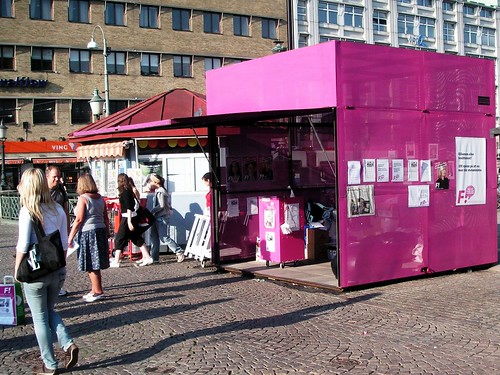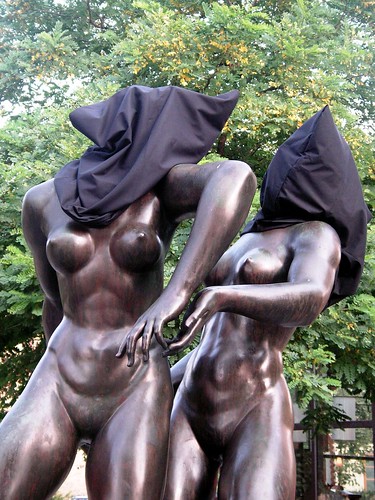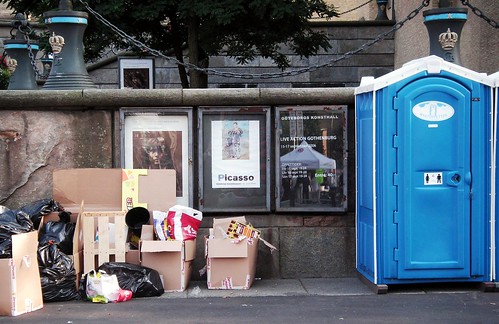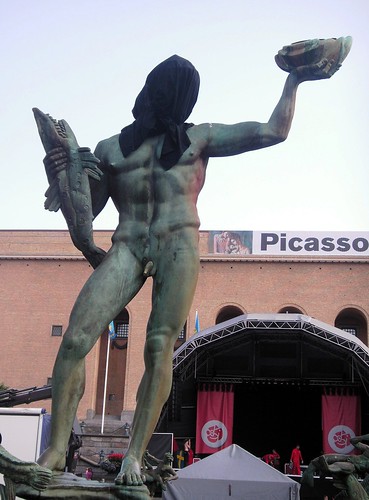The detritus of democracy or post-election blues
Well, now it's all over, but on the 17th September Sweden went to the polls to elect a new Riksdag (National Parliament) as well as all the Regional and Municipal Councils. The election was actually quite exciting, even though (as usual) I found it difficult to see much to choose between the political parties. The official pollsters tell us there was an 80.4% turn out, which is slightly up on the previous election 4 years ago (80.1%), which is good, but still means that 19.6% who had the right to vote, chose not to exercise it. Only two of the parties, the Social Democrats (Socialist) and the Moderates (Conservative) polled more than that, so the Sofa Party is still the third largest political group in Sweden.
As a long-time resident in Sweden, but without Swedish citizenship, I got to vote in the regional and local election, but not the national one. I can live with that. At local level, at least, politics has a more practical cast. It's also much easier to vote for a person at local or even regional level. Although the electoral system in Sweden is proportional, and so you cast your vote for a party list, there is the possibility to choose a particular candidate on a party list. You do this by putting a cross in the box against the name of your favourite. It's called "crossing for" (kryssa för). Some of the candidates who were low down on their party's lists, carried out personal campaigns to try to get themselves elected. A few managed. In Gothenburg, for example, the Christian Democrat, Annelie Enochson managed to get herself elected to the Riksdag over the head of her party colleague, Per Landgren (who lost his seat).
On a national level, too, the election seems largely to have been a matter of personalities. A lot of people voted against the Social Democrats as a protest against the party leader (and Prime Minister), Göran Persson. Persson has been seen increasingly as smug, self-satisfied, overbearing, presidential, patronising, distanced from the concerns of many people, a bully and a bore. Persson has now resigned as party leader.
On the other hand, the Moderates (who have been marketing themselves as the "new" Moderates - I wonder where they got that idea), seem to have attracted a lot of votes thanks to their leader, the dog-eyed Fredrik Reinfeldt. Reinfeldt will now take over as Prime Minister at the head of a coalition government of the right.
The other thing that almost certainly attracted votes from the left to the right was the right-wing Alliance group of parties united front, and their talking up employment as an issue. It's still baffling that the Social Democrats spent so long telling us how low the unemployment figures are and how this wasn't an issue they needed to worry about.

Alliance election cottages, originally uploaded by Gothenburg Observer.
One feature of Swedish elections which is very different from elections in England is the election cottages. Little villages of cottages or garden sheds spring up in various strategic spots. In central Gothenburg, this election, the best place to see the variety of cottages has been by walking from Brunsparken, near the centre of the city, up past Kungsportsplatsen along the Avenue to Götaplatsen, outside the Art Museum. The cottages are usually bought from garden suppliers or builder's merchants and really are garden sheds or Wendy houses. During the campaign, the parties sell lottery tickets and once the election has taken place the cottages are lotted out and quickly disappear into people's back gardens.

Feminist Initiative's cottage at Brunsparken, originally uploaded by Gothenburg Observer.
Sometimes, of course, one party or another will try to stand out a little from the crowd by doing something different in the way of a cottage. This year, the new feminist party, Feminist Initiative ("Fi" for short) has had the most remarkable utilitarian box shaped, lilac cottage. I have also seen the Greens (Miljöpartiet) use a greenhouse. I should think that was a bit hot.

Fliers mixed with commercial ads on a poster pillar on The Avenue. From the top down I see a personal campaign for a Folk Party candidate, Left Party fliers, and fliers for two Feminist Initiative candidates. , originally uploaded by Gothenburg Observer.
It seemed to me, this election, that the established right-wing parties didn't bother too much with fly posting, they obviously had money to invest in commercial posters (of which there were a good many). Both the Left Party and the Social Democrats stuck more to tradition as far as I could see. Traditionally (or at least for as long as I can remember), the parties are allowed to attach posters to sheets of hardboard and stake these out in various places - usually alongside roads - or fix them to lamp-posts. Traditionally, these posters are also regarded as fair game for defacement, though some destruction does seem to have been taken to an extreme.
On the 16th September, I did the walk from Brunsparken to Götaplatsen, taking pictures on the way. When I got to the square in front of the Art Museum, the Social Democrats were packing up after their big, final rally. Later that evening the square would be the site of a street party organised (without permission) by the anarchist group which calls it self "The Invisible Party" (Osynliga partiet). According to the local paper, quoting the police, the street party went off without trouble and the 200 or so youngsters who took part had dispersed by midnight.

Hooded statues outside Art Museum, originally uploaded by Gothenburg Observer.
Before then, I walked around the square and realised that many of the statues that decorate the space had their heads hooded with black cloth. I couldn't work out why this was, and I've not seen any explanation. If it hadn't been so close to the election, I'd have thought it a university student prank. As it is, it seemed like it could be anything from an installation to a protest about the election. Were the statues having their eyes hidden from the perfidy of the political process? Were they imitating prisoners at Guantanamo (and so protesting the Swedish government's perceived pro-American, pro-Israeli stance)? Were they hooded to suggest they were hiding their identities in a demand for greater individual freedom? Or were they hooded in black like prisoners before a firing squad to show that culture would be destroyed by the next government - of whatever colour?
Any thoughts?





0 Comments:
Post a Comment
<< Home